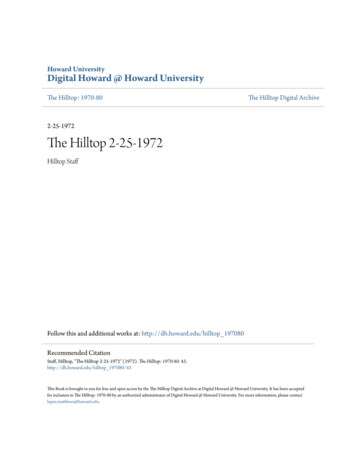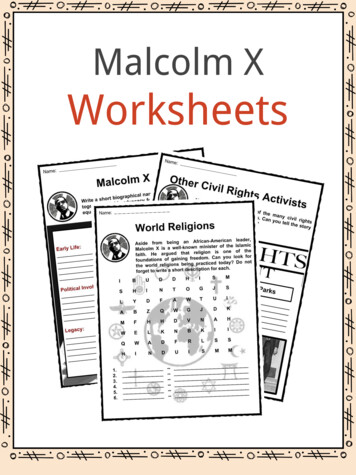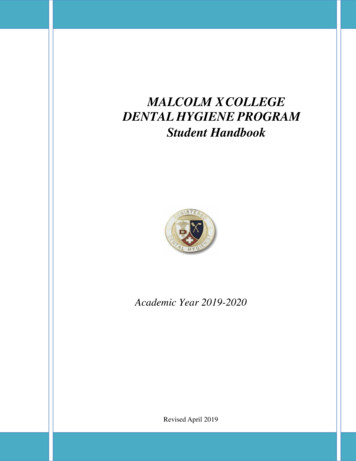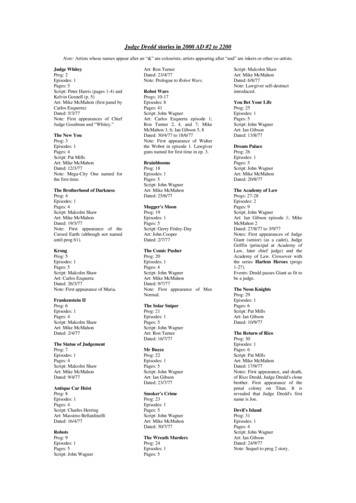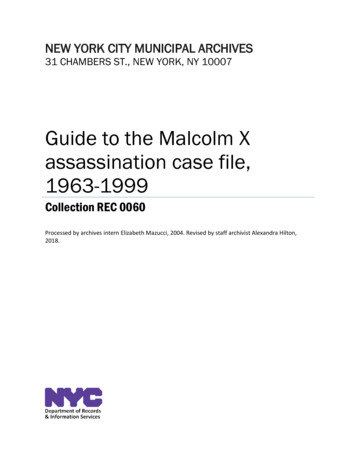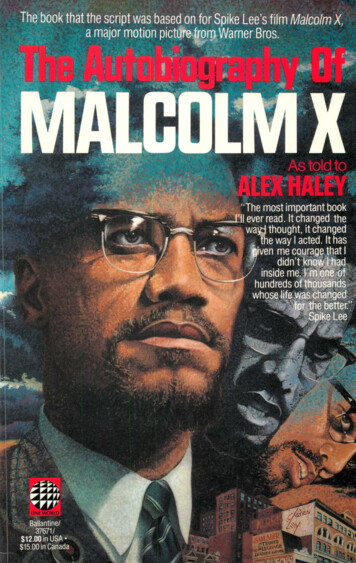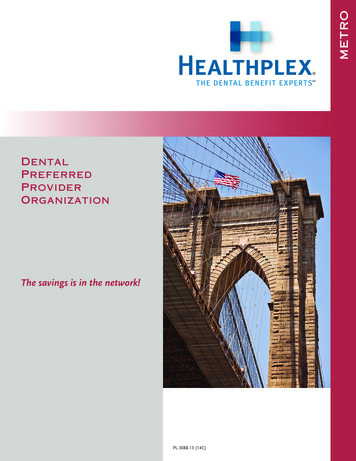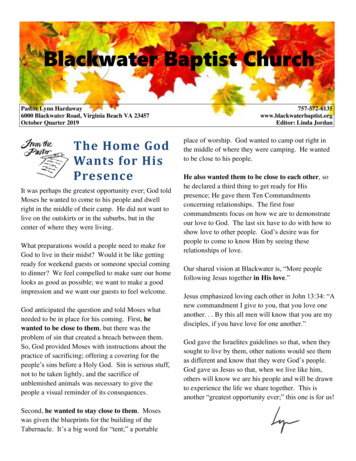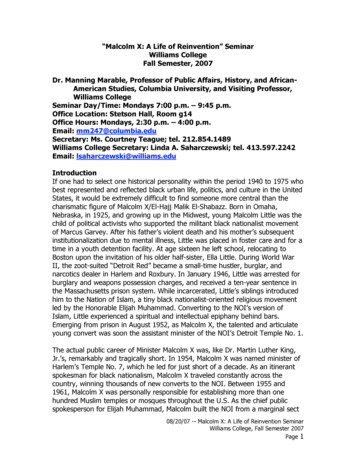
Transcription
“Malcolm X: A Life of Reinvention” SeminarWilliams CollegeFall Semester, 2007Dr. Manning Marable, Professor of Public Affairs, History, and AfricanAmerican Studies, Columbia University, and Visiting Professor,Williams CollegeSeminar Day/Time: Mondays 7:00 p.m. – 9:45 p.m.Office Location: Stetson Hall, Room g14Office Hours: Mondays, 2:30 p.m. – 4:00 p.m.Email: mm247@columbia.eduSecretary: Ms. Courtney Teague; tel. 212.854.1489Williams College Secretary: Linda A. Saharczewski; tel. 413.597.2242Email: lsaharczewski@williams.eduIntroductionIf one had to select one historical personality within the period 1940 to 1975 whobest represented and reflected black urban life, politics, and culture in the UnitedStates, it would be extremely difficult to find someone more central than thecharismatic figure of Malcolm X/El-Hajj Malik El-Shabazz. Born in Omaha,Nebraska, in 1925, and growing up in the Midwest, young Malcolm Little was thechild of political activists who supported the militant black nationalist movementof Marcus Garvey. After his father’s violent death and his mother’s subsequentinstitutionalization due to mental illness, Little was placed in foster care and for atime in a youth detention facility. At age sixteen he left school, relocating toBoston upon the invitation of his older half-sister, Ella Little. During World WarII, the zoot-suited “Detroit Red” became a small-time hustler, burglar, andnarcotics dealer in Harlem and Roxbury. In January 1946, Little was arrested forburglary and weapons possession charges, and received a ten-year sentence inthe Massachusetts prison system. While incarcerated, Little’s siblings introducedhim to the Nation of Islam, a tiny black nationalist-oriented religious movementled by the Honorable Elijah Muhammad. Converting to the NOI’s version ofIslam, Little experienced a spiritual and intellectual epiphany behind bars.Emerging from prison in August 1952, as Malcolm X, the talented and articulateyoung convert was soon the assistant minister of the NOI’s Detroit Temple No. 1.The actual public career of Minister Malcolm X was, like Dr. Martin Luther King,Jr.’s, remarkably and tragically short. In 1954, Malcolm X was named minister ofHarlem’s Temple No. 7, which he led for just short of a decade. As an itinerantspokesman for black nationalism, Malcolm X traveled constantly across thecountry, winning thousands of new converts to the NOI. Between 1955 and1961, Malcolm X was personally responsible for establishing more than onehundred Muslim temples or mosques throughout the U.S. As the chief publicspokesperson for Elijah Muhammad, Malcolm built the NOI from a marginal sect08/20/07 -- Malcolm X: A Life of Reinvention SeminarWilliams College, Fall Semester 2007Page 1
to a spiritual organization of over one hundred thousand. By the early 1960s,Malcolm X was a widely celebrated (and feared) public speaker and debater atuniversities and in the national media. The Federal Bureau of Investigation’sefforts to discredit the Nation and its leaders led the agency to engage in illegalacts of wiretapping, surveillance, disruption, and harassment.In 1960 Malcolm X established the newspaper Muhammad Speaks, which by theend of the decade would have a national circulation of 600,000, the most widelyread black-owned newspaper in the country. However, by this time, seriousdivisions developed between Malcolm X and the NOI’s patriarch, ElijahMuhammad, and his coterie of organizational leaders based in Chicago, over anumber of issues. Malcolm X was personally dismayed when it was publiclyrevealed that Muhammad had fathered a number of children out of wedlock. Healso chafed under the NOI’s political conservatism and its refusal to support civilrights protests. In March, 1964, Malcolm X announced publicly his break from theNOI. He soon created two new organizations, the Muslim Mosque, Inc., designedfor former NOI members as a spiritually-based group, and the secular-orientedOrganization of Afro-American Unity (OAAU). Now reaching out to Dr. MartinLuther King, Jr., James Farmer, and other civil rights leaders, Malcolm Xproposed a broad coalition of black activist organizations, working in concert toachieve social justice.Converting to orthodox Islam, Malcolm X completed his spiritual hajj to Mecca inApril, 1964, and returned to the United States the next month as El-Hajj Malik ElShabazz. During his two extended journeys through Africa and the Middle East in1964, Malcolm X gained new insights into the problem of racism. In hisAutobiography, he later wrote: “I was no less angry than I had been, but at thesame time the true brotherhood I had seen had influenced me to recognize thatanger can blind human vision.” He now believed that race war was notinevitable, and felt that “America is the first country that can actually have abloodless revolution.”Malcolm X’s new political strategy called for building black communityempowerment, through tools such as voter registration and education, economicself-sufficiency, and the development of independent politics. He called uponAfrican Americans to transform the civil rights movement into a struggle forinternational human rights. Malcolm X emphasized the parallels between theAfrican-American struggle for equality and the Asian, Latino, and Africancampaigns against European colonialism. Malcolm X also drew attention forcriticizing the growing U.S. military involvement in Vietnam.Upon Malcolm X’s return to the United States in November 1964, death threatsescalated against him and his family. In the early morning hours of February 14,1965, his home in Elmhurst, Queens, was firebombed. On Sunday afternoon,08/20/07 -- Malcolm X: A Life of Reinvention SeminarWilliams College, Fall Semester 2007Page 2
February 21, 1965, just before delivering an address at the Audubon Ballroom,Malcolm X/El-Hajj Malik El-Shabazz was assassinated before a crowd of hundredsof people, including his pregnant wife Betty Shabazz and children.The profound religious and political sojourn of Malcolm X was hardly noticed inthe immediate aftermath of his assassination. The New York Times editorializedthat Malcolm was “an irresponsible demagogue” and “an extraordinary andtwisted man,” who had utilized his “true gifts to evil purpose.” Time magazinedeclared that the dead leader was “an unashamed demagogue” whose “gospelwas hatred.” But others saw Malcolm X more clearly. President Kwame Nkrumahof Ghana sent a telegram of condolence to Malcolm’s widow, saying that “yourhusband lived a life of dedication for human equality and dignity so that the AfroAmerican and people of color everywhere may live as man. His work in the causeof freedom will not be in vain ”Today, over forty years after his assassination, the world largely views Malcolm Xas a champion of human rights. His Autobiography of Malcolm X, co-authoredwith Alex Haley, has sold millions of copies worldwide, and in 1999 was judgedby Time magazine as one of the ten “most important non-fiction works of thetwentieth century.”In 2000, the Malcolm X Project at Columbia University was established primarilyto accomplish two goals: (1) to construct a web-based, multimedia version ofThe Autobiography of Malcolm X, embedding more than one thousand pieces ofdata – e.g., videotaped interviews, FBI documents, personal correspondence byMalcolm X, audiotaped sermons and speeches – into the text; and thecompletion of a full-length, detailed biography of the subject. The multimediaversion of the Autobiography was constructed between 2001 and 2004 with thesupport of Columbia University’s Office of the Provost. The biographical researchon Malcolm X has, to date, produced a chapter on the subject in Living BlackHistory (New York: Basic Civitas, 2006), and a book-in-progress, to be publishedby Viking/Penguin Books in 2009. In the process, we have also constructed asignificant “Malcolm X Archive” of thousands of articles, FBI documents, rareaudiotape recordings of speeches and interviews related to Malcolm X.This seminar on the life and times of Malcolm X provides an original andchallenging reinterpretation of one of the most prominent American leaders ofthe twentieth century. By the end of the seminar, I hope you will come toappreciate the meaning of literary scholar Edward Said’s remark, when hesuggested in his book, Representations of the Intellectual that the goal of nonWestern intellectuals “cannot be to replace a white policeman with his nativecounterpart, but rather the invention of new souls.” Malcolm Little inventedand re-invented himself many times, as “Detroit Red,” “Jack Carlton” (in 1944,when Malcolm worked briefly as a bar entertainer and drummer at Manhattan’s08/20/07 -- Malcolm X: A Life of Reinvention SeminarWilliams College, Fall Semester 2007Page 3
Lobster Pond nightclub), “Satan” (during Malcolm’s first year in prison), “MalcolmX,” and “El-Hajj Malik El-Shabazz.” But in a larger political context, Malcolmstrove to motivate the construction of “new souls.” Oppressed people, Malcolm Xhad learned, could not become free unless they were first made to feelthemselves to be “new souls.”SEMINAR REQUIREMENTSThere are several essential components which are required for the successfulcompletion of this seminar:1. Class participation and attendance: Students are expected to read therequired readings before each class. All students are expected to participate inclass discussions, and to miss a minimum number of classes. All students mustregularly post comments on Blackboard at least once every two weeks (6 times)– either about the required readings, or about issues discussed in previousclasses – throughout the course, beginning in Week II. The class participationgrade includes the quality of our CourseWorks postings, regular attendance,individual visits with the professors, and most of all, willingness to raisethoughtful questions and to engage in discussion with other students. Classparticipation and attendance constitute 20 percent of the total course grade.2. Class short paper and oral presentation of the required week’s readings. Allstudents in the seminar will present a brief overview or synopsis of the mainthemes and topics discussed in one of the weekly required readings, coveringWeeks III through Week XII. Each weekly presentation includes: (1) a two-pagesummary of the major points of themes that the authors discuss in their papers,which must be posted on our course webpage no later than Friday by 12:00noon prior to the date of the Monday seminar meeting; (2) a brief, ten-minuteoral presentation to the seminar on the key ideas and themes in the readings;and (3) answering questions about the readings, and leading the seminar in adiscussion on the readings for forty-five minutes. All three components – thetwo-page paper posted on Friday, the oral presentation, and the quality of yourdiscussion – constitute 20 percent of your total course grade.If there are two or more students who are assigned to present during aparticular week, all students must review all of the readings in their respectiveindividual summaries. During their brief oral presentations, student may chooseto focus their remarks on specific texts, dividing materials with other presenters.However, all presenters are expected to be able to answer any questionspertaining to all of the readings.3. A brief bibliography, written summary, and brief oral presentation or researchpapers-in-progress. At the EXTRA seminar meeting of Week VII (Tuesday,08/20/07 -- Malcolm X: A Life of Reinvention SeminarWilliams College, Fall Semester 2007Page 4
November 6 from 4:15-6), all students will give a brief, five-minute overview oftheir research paper which includes a list of books, journal articles, archivalmaterials (if relevant), newspaper articles, and other important sources abouttheir subject, plus a 150 to 250 word description of the key themes or issuesthey want to examine about the subject. These bibliographies and short papersmust be posted on our Blackboard webpage no later than Friday, November 2,by 12:00 noon prior to the Tuesday afternoon seminar meeting. Bothcomponents – the two-page bibliography and written summary, and your oralpresentation – constitute 10 percent of your total course grade. (Studentswho cannot attend class on November 6 will present on Monday, November 5.)4. Present research papers-in-progress to the class for discussion and evaluationduring Week XI (December 3). All students will give a five-minute oralpresentation of their research paper, followed by questions from the seminarstudents and Professor Marable about their papers. The papers-in-progress mustbe posted on our Blackboard website no later than Friday, November 30 by 5:00p.m. Both components – the paper-in-progress, and your oral presentation andability to answer questions pertaining to your topic – constitute 10 percent ofyour total course grade.5. Final seminar research paper. Each student must write a 20-page-paperexcluding a bibliography and footnotes. Research papers should be at least 20typed, double-spaced pages, plus footnotes and a one-page bibliography ofsources used in the preparation of the paper. The papers are due Thursday,December 6, 2007, not later than 5:00 p.m. You will submit your paperelectronically, via email.You may utilize the texts in the required readings as part of the materials in theconstruction of your papers. The seminar paper is 40 percent of the totalcourse grade.Late papers will be accepted up to and including December 13, 2007, but will bepenalized by two points, plus one additional point for every day that they arelate. Please be aware of my late grade policy. I do not grant incompletes orextensions for unfinished work. It is far better to turn in a paper that is “notquite finished” than to turn it in eight days late. The exceptions made to theincomplete policy are for reasons of medical and/or family emergencies. Theseexceptions must be required in writing prior to the final day of class, December3.08/20/07 -- Malcolm X: A Life of Reinvention SeminarWilliams College, Fall Semester 2007Page 5
COURSE EVALUATION AND GRADING1) Class attendance, biweekly Blackboard postings, andparticipation in class discussions:2) Class short paper (2 pages on course webpage posted byFriday, 12:00 noon), and oral presentation (10 minuteslength) of the required week’s readings, and 40 minute classdiscussions:3) A brief bibliography, written summary and oralpresentation of research papers-in-progress, on Tuesday,November 6:4) Presentation of research papers-in-progress and classdiscussion, on December 3 (posted by Nov. 30):5) Final seminar research paper due Thursday, Dec. 6:TOTAL COURSE GRADE:20 percent20 percent10 percent10 percent40 percent100 percentREQUIRED READINGS:1) Breitman, George, ed., Malcolm X Speaks (New York: Grove WeidenfeldPublishers, 1990). ISBN 0-8021-3213-8.2) Clark, Steve, ed., February 1965: The Final Speeches (New York: Pathfinder,1992). ISBN 0-8734-8749-4.3) DeCaro, Jr., Louis, On the Side of My People: A Religious Life of Malcolm X(New York: New York University Press, 1996). ISBN 0-8147-1864-7.4) Marable, Manning, ed., Malcolm X Sourcebook (2007). (All of the readings inthe Sourcebook have been digitized and are available on the Blackboard.)5) Multimedia Study Environment (MSE), The Autobiography of Malcolm X.6) Malcolm X with Alex Haley, The Autobiography of Malcolm X (New York:Ballantine Books, 1973). ISBN 0-3453-5068-5. (The autobiography isavailable in its entirety electronically for the purposes of this course.)7) Turner, Richard Brent, Islam in the African-American Experience(Bloomington: Indiana University Press, 1997). ISBN 0-2532-1104-2.8) www.malcolmxproject.net. The website contains short interviews andmaterials that should be read for the seminar.A number of required readings for the course are on Blackboard, and areindicated in the syllabus under the specific weeks that they are assigned.08/20/07 -- Malcolm X: A Life of Reinvention SeminarWilliams College, Fall Semester 2007Page 6
RECOMMENDED VIEWING:Spike Lee, Malcolm X (Burbank, California: Warner Home Video, 1992).Orlando Bagwell, Malcolm X: Make It Plain (Boston, MA: Blackside Inc. 1993).E-course, “Malcolm X: Life After io/results zx.jsp.OPTIONAL READING:Some of these texts should be available at the Williams College Library:Breitman, George, The Last Year of Malcolm X (New York: Pathfinder Press,1967). ISBN 0-8734-8003-1.Clegg, Claude Andrew, An Original Man: The Life and Times of Elijah Muhammad(New York: St. Martin’s Press, 1998). ISBN 0-3121-8153-1.Collins, Rodnell P., and Peter Bailey, Seventh Child: A Family Memoir of MalcolmX (New York: Kensington Publishing Corp., 1998). ISBN 0-7582-0117-6.Cone, James H., Martin and Malcolm and America (Maryknoll, New York: OrbisBooks, 1992). ISBN 0-88344-824-6.DeCaro, Jr., Louis, Malcolm and the Cross: The Nation of Islam, Malcolm X, andChristianity (New York: New York University Press, 1998). ISBN 0-8147-1932-5.Goldman, Peter, The Death and Life of Malcolm X (New York: Harper and Row,1973). ISBN 0-2520-0774-3.Perry, Bruce, Malcolm: The Life of a Man Who Changed Black America(Barrytown, New York: Station Hill Press, 1991). ISBN 0-8826-8103-6.Perry, Bruce, ed., Malcolm X: The Last Speeches (New York: Pathfinder, 1985).IBN 0-8734-8543-2.Rickford, Russell J., Betty Shabazz: A Life Before & After Malcolm X (Naperville,IL: Sourcebooks, 2003). ISBN 1-4022-0171-0.Sales, Jr., William W., From Civil Rights to Black Liberation: Malcolm X and theOrganization of Afro-American Unity (Boston: South End Press, 1994). ISBN 089608-480-9.08/20/07 -- Malcolm X: A Life of Reinvention SeminarWilliams College, Fall Semester 2007Page 7
SEMINAR CALENDAR: “MALCOLM X: A LIFE OF REINVENTION”SEMINAR – FALL 2007 – at a glance:WEEKIDATESept. 10IISept. 17IIIIVVIISept. 24Oct. 1Oct. 8Oct. 15Oct. 22Oct. 29Nov. 5VIIINov. 6IXNov. 12XXIXIIXIIINov. 19Nov. 26Dec. 3Dec. 6Dec. 13VVINOTEIntroduction to the seminar’s requirements; introductionto MSE; and background on Malcolm X; biography,Malcolm X: A Life of Reinvention.Malcolm X’s childhood, “Detroit Red,” and Islam in BlackAmerica.Prison Years and Early Ministry, 1946-1955.The Nation of Islam, 1955-1960[Fall Reading Period: No Class.]The National Spokesman, 1960-1962.Malcolm X, M. L. King, Jr., and the Civil Rights Movement[Class Canceled]The Silencing, Muhammad Ali, and Out: December, 1963– April 1964.Extra class meeting, 4:15 – 6:00 p.m.Students Report on Papers in ProgressA New Vision? The Epiphany of Mecca and AfricanSojourner, 1964.1965: The Final Months.February 21, 1965: The Assassination and Aftermath.Presentation of Research Papers, posted Nov. 30.Final Research papers are due, 5 p.m. electronicallyFinal date for submitting research papers with latepenalty.COURSE SCHEDULE AND READING ASSIGNMENTSI. September 10: “Introduction: Rediscovering Malcolm X’s Life and Legacy.”Introduction to the seminar; review of seminar requirements; introductionto website, www.malcolmxproject.net; introduction to the “MultimediaStudy Environment (MSE) Autobiography; and a lecture about mybiography, Malcolm X: A Life of Reinvention.Readings:1. M. S. Handler, “Introduction,” in Malcolm X with Alex Haley, TheAutobiography of Malcolm X, pp. xxv-xxx.2. Malcolm X with Alex Haley, The Autobiography of Malcolm X, Chapter 1.3. MSE: Chapter 1.08/20/07 -- Malcolm X: A Life of Reinvention SeminarWilliams College, Fall Semester 2007Page 8
II. September 17: “Malcolm’s Childhood, the Legend of ‘Detroit Red,’ andBackground on Islam in Black America.”Readings:1. Malcolm X/Haley, Autobiography, Chapters 2-9.2. MSE: Chapters 2-9.3. Richard Brent Turner, Islam in the African-American Experience, pp. 1-173.4. Louis De Caro, Jr., On the Side of My People, chapters 3-4, pp. 38-58.5. Blackboard readings:(1) Ted Vincent, “The Garveyite Parents of Malcolm X,” Black Scholar(March/April 1989), pp. 10-13.(2) Robin D.G. Kelley, “The Riddle of the Zoot: Malcolm Little and BlackCultural Politics During World War II,” in Joe Wood, ed., Malcolm X: InOur Own Image, pp. 155-182.(3) Rodnell Collins, Seventh Child, Chapter 4, pp. 38-47.6. www.malcolmxproject.net. Required viewing of interviews in section, “MalcolmX’s Childhood, ‘Detroit Red,’ and Islam in Black America.” Include commentariesby scholars Robin D.G. Kelley, Louis DeCaro, Jr., and Farah Jasmine Griffin, aswell as Peter Bailey, a member of Malcolm X’s Organization of Afro-AmericanUnity (OAAU).III. September 24: “The Prison Years and Early Ministry, 1946-1955.”Readings:1. Malcolm X/Haley, Autobiography, Chapters 10-13.2. MSE: Chapters 10-13.3. De Caro, On the Side of My People, chapters 5-8, pp. 59-110.4. Blackboard readings:(1) Rodnell Collins, Seventh Child, Chapter 6, pp. 70-82.(2) C. Eric Lincoln, The Black Muslims in America, Chapters 1, 4-5, pp. 31,63-129.5. Wayne Taylor, “Premillennium Tension: Malcolm X and the Eschatology of theNation of Islam,” Souls, Vol. 7, no. 1 (Winter 2005), pp. 52-65.6. www.malcolmxproject.net. Required viewing of interviews in section, “ThePrison Years and Early Ministry: 1945-55.”IV. October 1: “The Lost and the Found: The Nation of Islam, 1955-1960”.Readings:1. Malcolm X/Haley, Autobiography, Chapter 14.2. MSE: Chapter 14.3. De Caro, On the Side of My People, Chapter 9-12, pp. 111-170.08/20/07 -- Malcolm X: A Life of Reinvention SeminarWilliams College, Fall Semester 2007Page 9
4. Blackboard readings:(1) Malcolm X, “Unity,” (Spring 1960) in Louis E. Lomax, When the Wordis Given (Westport, CT: Greenwood Press, 1979), pp. 128-135.(2) Malcolm X, “Minister Malcolm X Enunciates the Muslim Program,” inMuhammad Speaks, September 1960 (excerpted).5. Sourcebook readings (available on Blackboard):(1) “What Courier Readers Think: Muhammad Articles Called Undesirable,”Pittsburgh Courier, August 31, 1957, sec. 2, p. 15.(2) “What Courier Readers Think: Malcolm X Fires Away at Principal,”Pittsburgh Courier, August 31, 1957, sec. 2, p. 5.(3) Moslem Announces Million Law Suit,” Pittsburgh Courier, November9, 1957, p. 1.(4) Moslems Await ‘D-Day’ in N.Y. Court,” Pittsburgh Courier, May 24,1958, p. 7(5) “Postpone Moslem Hearing,” Pittsburgh Courier, May 31, 1958, p. 3.(6) “TV Show Hits Black Groups,” Amsterdam News, July 25, 1959, p. 2.(7) “To Answer TV Critics: Muhammad Speaks Here on Sunday,”Amsterdam News, July 25, 1959, p. 2.(8) “Moslems Fight Back; Bar White Press,” Amsterdam News, August 1,1959, pp. 1, 31.(9) “Races: The Black Supremacists,” Time, August 10, 1959, NationalAffairs Column, pp. 4-5.(10) “Africa Eyes Us,” Amsterdam News, August 22, 1959.(11) Clark, “Rise in Racial Extremism Worries Harlem Leaders,” New YorkTimes, January 25, 1960, pp. 1, 18.(12) “Muslims Ask Foes to 6-Hour Rally,” Pittsburgh Courier, May 21,1960, p. 2.(13) Frankel, “Cuban in Harlem,” New York Times, September 20, 1960,p. 1.(14) “Malcolm X Explains Wee-Hour Visit to Castro at Theresa,” PittsburghCourier, October 1, 1960, p. 3.(15) Hailey, “Nkrumah Tells Rally in Harlem Negroes Form U.S.-AfricaBond,” New York Times, October 6, 1960, p. 18.(16) Terry, “Black Muslim Elijah’s Lowly Start,” Washington Post,December 12, 1960, p. A3.(17) Terry, “Black Muslims Told They’re ‘Chosen People’,” WashingtonPost, December 15, 1960, p. B12.(18) Terry, “Black Muslims’ Hate Campaign Criticized,” Washington Post,December 16, 1960. p. A18.6. www.malcolmxproject.net. Required viewing of interviews in section, “TheLost and the Found: The Nation of Islam, 1955-1960.”08/20/07 -- Malcolm X: A Life of Reinvention SeminarWilliams College, Fall Semester 2007Page 10
V. October 15: “The National Spokesman, 1960-1962.”Readings:1. Malcolm X/Haley, Autobiography, Chapters 15-16.2. De Caro, On the Side of My People, Chapter 13, pp. 171-188.3. MSE:(1) Chapters 15-16.(2) Multimedia Index: Malcolm X, Message to the Grass Roots, November10, 1963 (to be listened to in conjunction with the readings in Breitman)4. Blackboard readings:(1) Malcolm X, “A Partial Transcript of a Sermon, June 16, 1961,” In LouisDe Caro, Jr., Malcolm and the Cross, pp. 223-235.(2) Malcolm X, “Malcolm X Proclaims Muhammad as Man of the Hour:Address at Yale University (October 1962),” in Roy L. Hill, ed., Rhetoric ofRacial Revolt, pp. 304-317.5. Sourcebook readings (available on Blackboard):(1) Teague, “Negroes Say Conditions in U.S. Explain Nationalists’Militancy,” New York Times, March 2, 1961, pp. 1, 17.(2) O’Kane, “Muslim Negroes Suing the State,” New York Times, March19, 1961, pp. 1, 46.(3) Kihiss, “In Return for Years of Slavery, Four or Five States,” New YorkTimes, April 23, 1961, p. 406.(4) Cultist is Slain Battling Police,” New York Times, April 29, 1962, p. 72.(5) “In Los Angeles Riot: Charge Muslim was ‘Murdered’,” AmsterdamNews, May 5, 1962, pp. 1, 40.(6) Becker, “Cultists on Coast Denounce Police,” New York Times, May 6,1962, p. 73.(7) “Study Shows Los Angeles Police Were Investigating Muslims at Timeof Riot,” Amsterdam News, May 12, 1962, pp. 1, 2.(8) “Coast Muslims Face Riot Charges,” Pittsburgh Courier, May 12, 1962,p. 7.(9) “Los Angeles Tensions Up Over Police Brutality,” Pittsburgh Courier,May 19, 1962, p. 4.(10) “The Muslim Message: All White Men Devils, All Negroes Divine,”Newsweek, August 27, 1962, pp. 26-27.(11) “What Courier Readers Think: Muslim vs. Moslem!” PittsburghCourier, October 6, 1962, p. 13.(12) “Malcolm X in Court,” Amsterdam News, November 17, 1962, pp. 1,2.(13) “Amsterdam News Readers Write : Malcolm X Speaks,” AmsterdamNews, November 24, 1962, p. 39.(14) Turner, “Militancy Urged on U.S. Negroes,” New York Times,November 26, 1962, p. 18.08/20/07 -- Malcolm X: A Life of Reinvention SeminarWilliams College, Fall Semester 2007Page 11
(15) “Pulse of New York’s Public: No Compromise,” Amsterdam News,December 1, 1962, p. 10.(16) “L.A. Muslims Face Trial Over ‘Riot’,” Pittsburgh Courier, December15, 1962, p. 22.6. www.malcolmxproject.net. Required viewing of interviews in section, “TheNational Spokesman, 1960-1962.”VI. October 22: “Malcolm X, Dr. Martin Luther King, Jr., and the Politics of CivilRights, 1962-1963.”Readings:1. MSE: Multimedia Index: Malcolm X, “Success of Martin Luther King, Jr.,”Malcolm X Speaks Again, radio broadcast: Contact, May 25, 1964.2. Blackboard readings:(1) Malcolm X and James Farmer, “Separation or Integration: A Debate,”in Dialogue Magazine 3 (May 1962), pp. 14-18.(2) LeRoi Jones, “What Does Nonviolence Mean?” Home: Social Essays,pp. 133-154.(3) Manning Marable, “Malcolm, Martin and the Mandates of Justice,” inManning Marable, Speaking Truth to Power: Essays on Race, Resistanceand Radicalism, pp. 134-138.(4) Robin Kelley, “House Negroes on the Loose: Malcolm X and the BlackBourgeoisie,” Callaloo 21 (2) 1998:419-435.(5) James Baldwin, “Malcolm and Martin,” Esquire 77 (4) 1972: 94-97,195-196, 198, 201-202.(6) James Cone, Martin & Malcolm & America, Chapter 9, “Two Roads toFreedom,” pp. 244-271; Part of Chapter 10, “Nothing But Men,” pp. 272273, 280-287; Chapter 11, “Making Their Mark: Legacies,” pp. 288-314;and “Conclusion,” pp. 315-318.(7) The Playboy Interview: Malcolm X Speaks with Alex Haley (May1963),” in Gallen, ed., Malcolm X: As They Knew Him, pp. 109-130.(8) “Minister Malcolm: A Conversation with Kenneth B. Clark (June 1963),”in Gallen, ed., Malcolm X: As They Knew Him, pp. 131-134.(9) Malcolm X, “God’s Judgment of White America,” in The End of WhiteWorld Supremacy, pp. 121-148.3. Sourcebook readings (available on Blackboard):(1) “Muslims Press Race Separation,” New York Times, February 26, 1963,p. 3.(2) “X Marks the Spot,” Newsweek, May 6, 1963, p. 28.(3) Handler, “Malcolm X Starting Drive in Washington,” New York Times,May 10, 1963, pp. 1, 14.(4) Handler, “Malcolm X Terms Dr. King’s Tactics Futile,” New York Times,May 11, 1963, p. 9.08/20/07 -- Malcolm X: A Life of Reinvention SeminarWilliams College, Fall Semester 2007Page 12
(5) “Themes and Variations: Coffee with Malcolm X,” Wall Street Journal,May 16, 1963, p. 12.(6) Handler, “Malcolm X Scores Kennedy on Racial Policy,” New YorkTimes, May 17, 1963, p. 14.(7) “Why Black Muslims Are Focusing on the Nation’s Capital Now,” USNews & World Report, May 27, 1963, p. 24.(8) Malcolm X Disputes Nonviolence Policy,” New York Times, June 5,1963, p. 29.(9) Malcolm X, “Muslim Teachings,” New York Times, August 25, 1963, p.SM2.(10) “3 Negro Speakers on TV Hold Kennedy Leadership Inadequate,”New York Times, June 25, 1963, p. 13.4. Clayborne Carson, “The Unfinished Dialogue of Martin Luther King, Jr. andMalcolm X,” Souls, Vol. 7, no. 1 (Winter 2005), pp. 12-19.5. George Breitman, ed., Malcolm X Speaks, pp. 3-17.6. www.malcolmxproject.net. Required viewing of interviews in section, “MalcolmX, Martin Luther King, and the Civil Rights Movement.”VII. November 5: “The Silencing, Muhammad Ali, and Out, December 1963-April1964.”Readings:1. Richard Turner, Islam in the African-American Experience, pp. 174-214.2. Blackboard readings:(1) Plimpton, “Miami Notebook: Cassius Clay and Malcolm X,” Harper’sMagazine (June 1964), pp. 54-61.(2) George Breitman, ed., Malcolm X Speaks, “Introduction,” “The Split,”“The Transition Period,” and “Radicalism,” pp. 7-50.(3) Malcolm X, “His Best Credentials: On the Air with Joe Rainey” (March20, 1964), in Gallen, ed., Malcolm X: As They Knew Him, pp. 155-166.3. Sourcebook readings:(1) “Malcolm X Scores U.S. and Kennedy,” New York Times, December 2,1963, p. 21.(2) Apple, “Malcolm X Silenced for Remarks on Assassination of Kennedy,”New York Times, December 5, 1963, p. 22.(3) “Malcolm Expected to be Replaced,” New York Times, December 6,1963, p. 27.(4) “Elijah Suspends Malcolm,” Amsterdam News, December 7, 1963, pp.1-2.(5) “May Mean Policy Change: Muzzling of Malcolm X For IndefinitePeriod,” Pittsburgh Courier, December 14, 1963, p. 1.(6) “Nation Still Mourns Death,” Muhammad Speaks, December 20, 1963,pp. 1, 3.08/20/07 -- Malcolm X: A Life of Reinvention SeminarWilliams College, Fall Semester 200
In 1954, Malcolm X was named minister of Harlem's Temple No. 7, which he led for just short of a decade. As an itinerant spokesman for black nationalism, Malcolm X traveled constantly across the country, winning thousands of new converts to the NOI. Between 1955 and 1961, Malcolm X was personally responsible for establishing more than one

